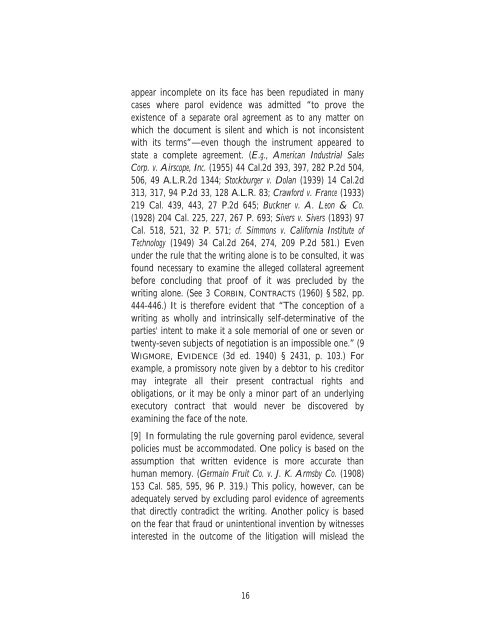Contract Doctrine, Theory & Practice Volume 3, 2012a
Contract Doctrine, Theory & Practice Volume 3, 2012a
Contract Doctrine, Theory & Practice Volume 3, 2012a
Create successful ePaper yourself
Turn your PDF publications into a flip-book with our unique Google optimized e-Paper software.
appear incomplete on its face has been repudiated in many<br />
cases where parol evidence was admitted “to prove the<br />
existence of a separate oral agreement as to any matter on<br />
which the document is silent and which is not inconsistent<br />
with its terms”—even though the instrument appeared to<br />
state a complete agreement. (E.g., American Industrial Sales<br />
Corp. v. Airscope, Inc. (1955) 44 Cal.2d 393, 397, 282 P.2d 504,<br />
506, 49 A.L.R.2d 1344; Stockburger v. Dolan (1939) 14 Cal.2d<br />
313, 317, 94 P.2d 33, 128 A.L.R. 83; Crawford v. France (1933)<br />
219 Cal. 439, 443, 27 P.2d 645; Buckner v. A. Leon & Co.<br />
(1928) 204 Cal. 225, 227, 267 P. 693; Sivers v. Sivers (1893) 97<br />
Cal. 518, 521, 32 P. 571; cf. Simmons v. California Institute of<br />
Technology (1949) 34 Cal.2d 264, 274, 209 P.2d 581.) Even<br />
under the rule that the writing alone is to be consulted, it was<br />
found necessary to examine the alleged collateral agreement<br />
before concluding that proof of it was precluded by the<br />
writing alone. (See 3 CORBIN, CONTRACTS (1960) § 582, pp.<br />
444-446.) It is therefore evident that “The conception of a<br />
writing as wholly and intrinsically self-determinative of the<br />
parties' intent to make it a sole memorial of one or seven or<br />
twenty-seven subjects of negotiation is an impossible one.” (9<br />
WIGMORE, EVIDENCE (3d ed. 1940) § 2431, p. 103.) For<br />
example, a promissory note given by a debtor to his creditor<br />
may integrate all their present contractual rights and<br />
obligations, or it may be only a minor part of an underlying<br />
executory contract that would never be discovered by<br />
examining the face of the note.<br />
[9] In formulating the rule governing parol evidence, several<br />
policies must be accommodated. One policy is based on the<br />
assumption that written evidence is more accurate than<br />
human memory. (Germain Fruit Co. v. J. K. Armsby Co. (1908)<br />
153 Cal. 585, 595, 96 P. 319.) This policy, however, can be<br />
adequately served by excluding parol evidence of agreements<br />
that directly contradict the writing. Another policy is based<br />
on the fear that fraud or unintentional invention by witnesses<br />
interested in the outcome of the litigation will mislead the<br />
16


















